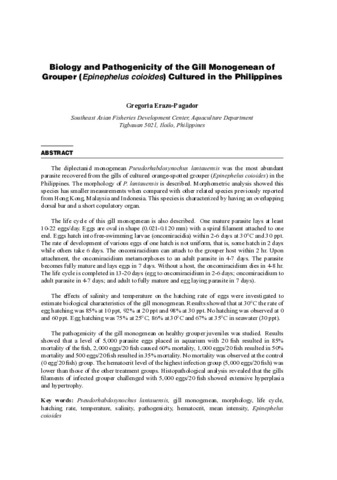Biology and pathogenicity of the gill monogenean of grouper (Epinephelus coioides) cultured in the Philippines
- Global styles
- MLA
- Vancouver
- Elsevier - Harvard
- APA
- Help

Date
2005-03Author
Page views
1,990ASFA keyword
AGROVOC keyword
Taxonomic term
Metadata
Show full item record
Share
Abstract
The diplectanid monogenean Pseudorhabdosynochus lantauensis was the most abundant parasite recovered from the gills of cultured orange-spotted grouper (Epinephelus coioides) in the Philippines. The morphology of P. lantauensis is described. Morphometric analysis showed this species has smaller measurements when compared with other related species previously reported from Hong Kong, Malaysia and Indonesia. This species is characterized by having an overlapping dorsal bar and a short copulatory organ.
The life cycle of this gill monogenean is also described. One mature parasite lays at least 10-22 eggs/day. Eggs are oval in shape (0.021-0.120 mm) with a spiral filament attached to one end. Eggs hatch into free-swimming larvae (oncomiracidia) within 2-6 days at 30°C and 30 ppt. The rate of development of various eggs of one hatch is not uniform, that is, some hatch in 2 days while others take 6 days. The oncomiracidium can attach to the grouper host within 2 hr. Upon attachment, the oncomiracidium metamorphoses to an adult parasite in 4-7 days. The parasite becomes fully mature and lays eggs in 7 days. Without a host, the oncomiracidium dies in 4-8 hr. The life cycle is completed in 13-20 days (egg to oncomiracidium in 2-6 days; oncomiracidium to adult parasite in 4-7 days; and adult to fully mature and egg laying parasite in 7 days).
The effects of salinity and temperature on the hatching rate of eggs were investigated to estimate biological characteristics of the gill monogenean. Results showed that at 30°C the rate of egg hatching was 85% at 10 ppt, 92% at 20 ppt and 98% at 30 ppt. No hatching was observed at 0 and 60 ppt. Egg hatching was 75% at 25°C, 86% at 30°C and 67% at 35°C in seawater (30 ppt).
The pathogenicity of the gill monogenean on healthy grouper juveniles was studied. Results showed that a level of 5,000 parasite eggs placed in aquarium with 20 fish resulted in 85% mortality of the fish, 2,000 eggs/20 fish caused 60% mortality, 1,000 eggs/20 fish resulted in 50% mortality and 500 eggs/20 fish resulted in 35% mortality. No mortality was observed at the control (0 egg/20 fish) group. The hematocrit level of the highest infection group (5,000 eggs/20 fish) was lower than those of the other treatment groups. Histopathological analysis revealed that the gills filaments of infected grouper challenged with 5,000 eggs/20 fish showed extensive hyperplasia and hypertrophy.
Suggested Citation
Erazo-Pagador, G. (2005). Biology and pathogenicity of the gill monogenean of grouper (Epinephelus coioides) cultured in the Philippines. In K. Nagasawa (Ed.), Recent Advances in Diagnosis and Prevention of Fish and Shrimp Diseases in Southeast Asia (pp. 295–308). Tigbauan, Iloilo, Philippines: Aquaculture Department, Southeast Asian Fisheries Development Center.
Type
Book chapterISBN
9718511732
Related items
Showing items related by title, author, creator and subject.
-
Temporal changes in innate immunity parameters, epinecidin gene expression, and mortality in orange-spotted grouper, Epinephelus coioides experimentally infected with a fish pathogen, Vibrio harveyi JML1
Amar, Edgar C. ; Faisan, Joseph P., Jr.
; Faisan, Joseph P., Jr.  ; Apines-Amar, Mary Jane S.; Pakingking, Rolando V., Jr.
; Apines-Amar, Mary Jane S.; Pakingking, Rolando V., Jr.  (Elsevier, 2017)
Changes in innate immunity parameters and epinecidin mRNA transcript levels were examined to characterize the non-specific immune response of E. coioides to pathogenic V. harveyi JML1 isolated from affected cage-cultured ...
(Elsevier, 2017)
Changes in innate immunity parameters and epinecidin mRNA transcript levels were examined to characterize the non-specific immune response of E. coioides to pathogenic V. harveyi JML1 isolated from affected cage-cultured ... -
Detection and identification of viral pathogens of grouper (Epinephelus malabaricus) cultured in Thailand
Kanchanakhan, Somkiat; Dolnayadol, Yaowanit; Roongkamnertwongsa, Somporn (Aquaculture Department, Southeast Asian Fisheries Development Center, 2005-03)A virological survey was conducted in brown-spotted grouper (Epinephelus malabaricus) cultured in cages, earthen ponds and pens from April 2001 to January 2002 on the east and south coasts of Thailand. The adult grouper ... -
Distribution of nervous necrosis virus in orange-spotted grouper Epinephelus coioides with asymptomatic infection
Kiryu, Ikunari; de la Peña, Leobert D.; Maeno, Yukio (Japanese Society of Fish Pathology, 2007)Distribution of nervous necrosis virus in asymptomatically infected orange-spotted grouper Epinephelus coioides was determined by PCR assay in this study. Fourteen different tissues and organs were collected from apparently ...

 AQD Access
AQD Access




